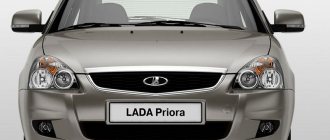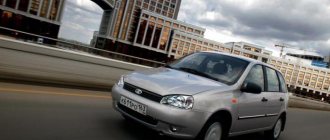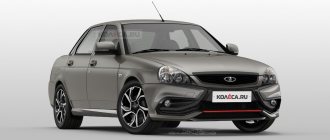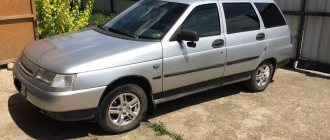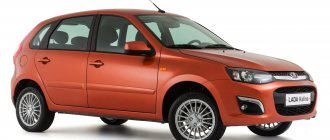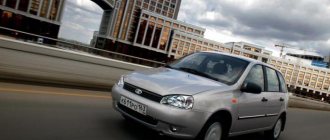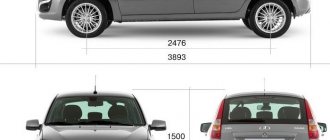Lada Priora became the successor of the VAZ-2110, adopting several elements from it and gaining the sympathy of domestic car owners - where would we be without cans. About 400 parts were redone. In its segment, Lada Priora receives one of the best ratings due to its unpretentiousness and good performance. But what exactly is worth saying about the car is that the technical characteristics of the Priora car are quite decent for its class.
AvtoVAZ introduced the VAZ-2170 model in the mid-2000s, Priora was produced from 2007 to 2022, and in 2013 it underwent restyling with minor changes. Over the years, a large number of VAZ cars have been produced, and many ideas have emerged to improve and stylize Lada Priora cars. Technical characteristics are the point at which an experienced driver chooses a car; you shouldn’t buy it for its pretty eyes. Although look at the picture below and her eyes. 
Description
LADA Priora station wagon (aka VAZ 2171) is a Russian passenger car with a station wagon body. Created on the basis of the LADA Priora sedan (VAZ-2170). Serial production of commercial vehicles began on May 27, 2009. By the end of May, 250 new station wagons were produced according to plan, and sales through the dealer network began on June 20, 2009.
The Lada Priora station wagon is a deep modernization of the VAZ-2111 with a completely changed body design, including the rear part with original body panels and lighting equipment. The rear side windows are installed without plastic covers; their shape has changed (they expand upward). The rear lights from the door were moved to the body and installed in a vertical layout. There are brackets on the wheel arches of the trunk to secure the cargo.
Characteristics of VAZ 2171
| Engine | 1.6 l, 16-cl |
| Length, mm | 4210 |
| Width, mm | 1680 |
| Height, mm | 1420 |
| Base, mm | 2492 |
| Front wheel track, mm | 1410 |
| Rear wheel track, mm | 1380 |
| Luggage compartment volume, dm 3 | 444/777 |
| Weight in running order, kg | 1088 |
| Gross vehicle weight, kg | 1578 |
| Permissible total weight of a towed trailer with brakes, kg | 800 |
| Permissible total weight of the lettered trailer without brakes, kg | 500 |
| Wheel formula/drive wheels | 4x2/front |
| Car layout diagram | front-wheel drive, front engine, transverse |
| Body type/number of doors | station wagon/5 |
| engine's type | gasoline, four-stroke |
| Supply system | Electronically controlled distributed injection |
| Number and arrangement of cylinders | 4, in-line |
| Engine displacement, cm 3 | 1596 |
| Maximum power, kW/rpm | 72 / 5600 |
| Maximum torque, Nm at rpm | 145 / 4000 |
| Fuel | unleaded gasoline AI-95 (min) |
| Fuel consumption by driving cycle, l/100 km | 7,2 |
| Maximum speed, km/h | 183 |
| Transmission | With manual control |
| Number of gears | 5 forward, 1 reverse |
| Main gear ratio | 3,7 |
| Steering | rack and pinion type, electric power steering |
| Tires | 185/65 R14 86(H) 175/65 R14 82(H) 185/60 R14 82(H) |
| Fuel tank capacity | 43 |
The technical characteristics of the Lada Priora station wagon differ in many respects from the characteristics of the sedan and hatchback in terms of interior roominess. The huge trunk for a domestic car makes it a convenient car for those who constantly carry large items.
The front-wheel drive passenger station wagon LADA Priora (VAZ 2171) is one of the popular models of the Tolyatinsk automobile plant. The concept car, which later became the prototype of the new VAZ 2171 Priora station wagon, was demonstrated for the first time in 2005. However, it was officially shown only in the fall of 2008.
In the spring of 2009, the first production station wagon, the VAZ 2171 Priora, rolled off the assembly line and entered the VAZ family of cars on an equal footing, where it was expected:
- sedan 2170 Priora - produced since 2007;
- hatchback 2172 Priora - manufactured since 2008.
In 2012, the VAZ 2171 Priora station wagon took first place in sales in Russia. Then the demand for it began to fall, which is why the production of the station wagon was discontinued.
Appearance
AvtoVAZ engineers did not invent a bicycle and simply took the sedan body as a basis. So, from the front these cars are completely identical. The Lada Priora station wagon has the same drop-shaped halogen headlights, as well as a modest bumper with round fog lights.
There are massive roof rails on the roof. True, judging by the reviews, none of the owners practically used them. It is worth noting that the angle of the rear door pillar has been reduced. This has a positive effect on the ease of landing. Getting into a station wagon is much more comfortable than sitting in a sedan.
Note that in 2011 the car underwent a slight restyling. Thus, the Lada Priora station wagon body remained virtually unchanged. Among the differences are a larger radiator grille with chrome trim, as well as a reshaped bumper with different foglights. The rest of the car remained the same.
From the rear, the car doesn't look like any kind of van. This is facilitated by large vertical lights and the successful completion of the rear pillar. The trunk lid is quite large and has heated glass. The bumper is raised high, which contributes to good cross-country ability.
Operational and technical characteristics
The VAZ 2171 Priora station wagon is a budget car and its technical parameters do not stand out in any way from the general background of AvtoVAZ products.
Power unit
The Priora 2171 station wagon was equipped with two VAZ-made engines with technical characteristics:
For those who are interested in purchasing a Lada Priora station wagon, the technical characteristics of the body, engine and suspension are equally important. "Lada Priora" is the direct heir and successor of the flagship family of VAZ 2110 models of the Volzhsky Automobile Plant. Several hundred changes were made to the design of the car, so the VAZ-2170, VAZ-2171 and VAZ-2172 models (sedan, station wagon and hatchback, respectively) are considered to be a separate family. The first sedans went on sale in 2007, and station wagons in 2009. The Lada Priora station wagon is the most practical and spacious car in the family. At the end of 2015, AvtoVAZ stopped producing and accepting orders for this model.
Further more?
There is very little room for feet in the Priors. In the old one, when I pressed the gas, I often touched the brake pedal. Because of this, you have to move your leg to the right and turn your foot out.
I don’t even want to think about what will happen to my leg in the event of an accident. It is better to sit in the updated car due to the fact that the distance between the gas and brake pedals has been increased by about 7 mm (up to 47 mm).
PLUS: The LED lights are good, the car has become more visible. The on-board computer screen is clear and understandable.
MINUS: Weak, uninformative brakes, and still cramped in the back.
We thank the Temp Auto Balashikha and Avtorezerv car dealerships for providing the cars for testing.
Restyling was carried out with little effort. The car has clearly become better, but you shouldn’t expect miracles from a long-lived Russian market driver. The shortcomings that require serious modifications to the body and chassis remain. We hope they will be eliminated in the new model that will replace the Priora at the end of 2015.
Source
Versions of the Priora station wagon
For the Lada Priora station wagon, three configuration options are possible:
- “Standard” is the cheapest (not produced since 2014).
- “Norma”, which includes an airbag for the driver, a brake system with a vacuum booster, front disc brakes, power steering, inertia seat belts, an anti-theft alarm, running lights for daylight hours, a fabric interior, and electric heated exterior mirrors.
- The “Lada Priora” station wagon “Lux” is distinguished by the fact that it has airbags for passenger seats in the first row, a rain sensor, electric windows in the rear doors, and alloy wheels. The interior finishing material is Alcantara (artificial suede). The front seats can be adjusted. In some cases, the Lada Priora Lux station wagon is equipped with parking sensors and a navigator.
In 2013, the car was restyled. Externally, the 2013 station wagon and the 2014 station wagon differ little. The new version features an updated radiator grille, side collars on the side mirrors, the front and rear bumpers have changed, and LEDs have been installed in the headlights.
The interior of the 2013 Priora station wagon has undergone major changes. It was modernized with the participation of the Italian design studio Carcerano. The car is now equipped with a three-spoke steering wheel, and a color monitor is installed in the center console to control the stereo system and display navigator information. In older trim levels, the front row seats are equipped with additional airbags and adjustable heating.
Color change
“First impressions: the car needs to be rolled out, it doesn’t drive. There is no sound insulation, locks and door handles require improvement. The standard tires are noisy and dull. You’re riding like you’re on stumps.”
“In two difficult months, the car covered 18,000 km, but did not cause any problems. The chassis, in my opinion, is quite tolerable, the only thing is that a knock is heard in the right pillar when passing speed bumps. I came to the service, looked at it - everything is fine, they say it’s their illness. The brakes are not bad, 4"...
I compare the impressions of Moscow Prior owners with my own. The cars have the same 98-horsepower engines, so there are no fundamental differences in movement. The suspensions regularly absorb large bumps, but shake on small bumps. However, the gray car is more interesting at the level of nuances: it is more composed in corners, a little more stable on the way out, and absorbs road bumps more smoothly.
In terms of acceleration dynamics, the new and old “Priors” are practically no different from each other, while a noticeable monotonous rumble fills the interior. I remember that during our first meeting with the car they told us about improving the sound insulation. We measured the noise level in the cabin (both Prioras were shod with the standard Kama-Euro) and were surprised: the new car turned out to be not as quiet as the previous version! The reason was found in the trunk: it turned out that the carpet in the pre-restyling car was thicker.
The steering is equally uninformative, and the updated car has a sharper steering wheel only in the Lux. We are waiting for him in other modifications.
“The transmission works fine, except for first gear. I switch to lower with effort. This happened to me on all Zhiguli cars, from the “six” to the “ten,” - I continue to study the forum of Prior owners.
The white Priora has a similar behavior, but here the fifth gear is difficult to engage. I push the lever by force, and it doesn’t work the first time. In a restyled car, it is more convenient to operate the lever. New cable driven unit? Unfortunately, no: both have well-known boxes with the VAZ-2112 index, which my colleague was not enthusiastic about when he tried out the new Priora in Tolyatti. Therefore, they decided: these are the features of specific machines. I would like to believe that the better performance of the transmission is evidence of improved build quality. By the way, when the engines are idling, the gearbox levers of our pair vibrate equally strongly.
The brakes lack information content and tenacity of reactions. The mechanisms seem to be lubricated with soap: I press the pedal - and every time I am dissatisfied with the rate of deceleration. I want to push the pedal harder, but the travel is not unlimited.
I remember the “Chinese” - “Lifan-Solano” and “FAW-Oley”, which I had a chance to ride on earlier. I liked the braking performance of these budget sedans much more. I wish the replacement of the Priora that her main automotive system becomes clearer and more reliable.
Well, although our pair is not in the richest configurations, there are more than enough differences between them. But there is also a “Lux”, in which you will find a multimedia system, side airbags and a more powerful 106-horsepower engine. But even without that, the old Priora still pales in comparison to the new one. However, only a new model can correct the global shortcomings of the Priora. Completely new in design.
Vehicle body and layout
Body type VAZ 2171 is a five-seater, five-door station wagon. The fifth door is solid and opens upward. The overall dimensions of the Lada Priora station wagon (body length, width and height) are 4210, 1680 and 1420 mm, respectively. The height is indicated taking into account the roof rails, which are not removable. For the Lada Priora station wagon, 10 body color options are offered: from black and dark red to white and silver. The "Lada Priora" station wagon in "Snow Queen" color is most suitable for southern regions, since it heats up less from the sun. In summer, cars of this color will not be so hot.
The vehicle's wheelbase (the distance between the front and rear axles) is 2492 mm. The front track is 1410 mm, the rear is slightly larger, its size is 1380 mm. Ground clearance (or ground clearance) is 170 mm. The trunk of the Priora station wagon has a volume of 444 cubic dm, and with the rear row seats folded, the volume will increase to 777 cubic dm, but the seats do not fold flat. Lada Priora 2171 has a front-wheel drive layout with a front transverse engine. The wheel arrangement is 4×2 (the car has 4 wheels, 2 of which are driving).
Trunk
The Lada Priora station wagon has a spacious trunk. So, in the five-seater version its volume is 444 liters. But as independent tests have shown, the actual volume is only 416 liters.
If you fold the backrest of the rear sofa, the volume increases to 778 liters. Features include a low loading line. Under the raised floor there is a niche for a full-size spare wheel.
Vehicle powertrain
Three engine options are available:
- 8-valve VAZ-2116 engine with a power of 90 horsepower;
- 16-valve VAZ-21126 engine with a power of 98 horsepower. The station wagon modification with engine 21126 (factory designation VAZ 217130) is the most affordable on the secondary market;
- The 16-valve VAZ-21127 engine, which produces 106 horsepower, wins in terms of efficiency and reliability.
The base engine of the Lada Priora 2171 model is a gasoline, four-stroke, four-cylinder (cylinders are arranged in a row) 16-valve VAZ-21127 engine with distributed injection. This engine appeared after the VAZ-21126 engine was modified to improve the intake system. On the VAZ 21127, instead of one mass air flow sensor, two are installed: absolute pressure and air temperature. This made it possible to get rid of the known problem of the previous model - fluctuations in the crankshaft speed at low speeds.
The volume of this engine is 1596 cubic cm, the diameter of each of the four cylinders is 82 mm, the piston stroke is 75.6 mm, the compression ratio is 11. The octane number of gasoline used is 95. This engine develops power up to 106 horsepower at crankshaft rotation speed 5800 rpm, and its maximum torque is 148 Nm at 4200 rpm. It is obvious that the characteristics of the VAZ Priora with the 21127 engine are 8 horsepower and 3 Nm higher than those of a car of the same brand with the 21126 engine.
The maximum speed of the Priora station wagon with engine 21127 is 183 km/h, acceleration to hundreds is possible in 11.5 seconds with a total weight of 1578 kg. Fuel consumption in the combined cycle is 6.8 liters per 100 km, and on the highway fuel consumption is 5.4 liters per 100 km. The fuel tank holds 43 liters of fuel. The manufacturer claims an engine life of 200 thousand km.
Chassis of the Lada Priora
The chassis of the Lada 2171 differs little from the proven and proven VAZ-2108 model. The front suspension is independent, McPherson type with straight forged arms. Barrel springs. The rear suspension is semi-independent, torsion bar, the beam is equipped with new shock absorbers, the springs are stiffer than those of the sedan. Both the front and rear suspensions have anti-roll bars. According to experts, the chassis of the Priora station wagon is well adapted to domestic road conditions; even on a road with potholes and gullies you can drive without slowing down.
The front brakes are ventilated disc brakes, the rear brakes are drum brakes. The brake system is dual-circuit (with diagonal separation of circuits), which ensures safety during emergency braking. Each circuit drives two wheels located diagonally across the vehicle. If one circuit fails, the second provides effective shutdown. The parking brake system has a cable drive to the rear brakes. The standard wheels have a size of 185/65 R14.
Brake system
The front and rear brakes are different. There are ventilated disc brakes with a single-piston floating caliper and automatic adjustment of the gap between the pads and the disc at the front, and drum brakes at the rear. The brake system is diagonal, dual-circuit, hydraulic. Equipped with a vacuum booster.
It is possible to work with the traction control system. You can also install disc brakes at the rear instead of standard drum brakes. The new braking system will also support ABS. The parking brake is manual, on a cable with drive of the rear wheels.
